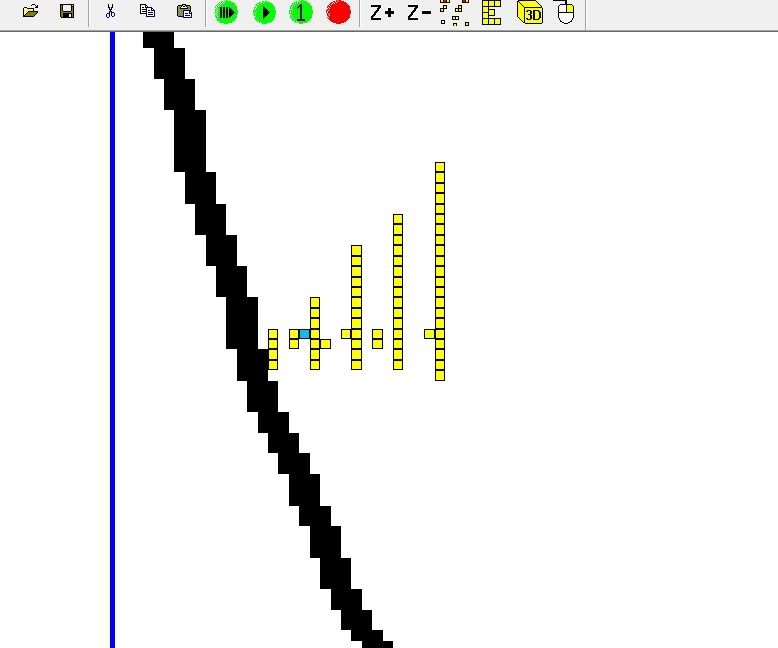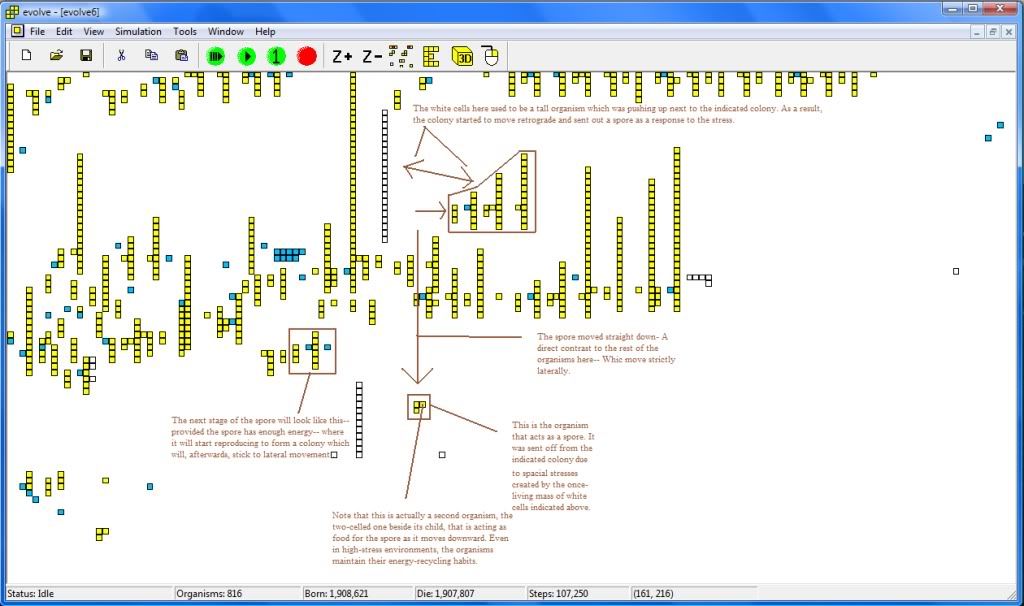This was just so awesome, I had to share this with you people:
Copyposta from my thread on another forum:
"...So I just got through reading the Lost World again, and I've been working with this neat little procedural program called 'Evolve 4.0' for a while, just playing around with it really. The other day, though, I started a simulation with a super simple organism (By the Sim's standards at least, it is extremely small and simple (All it does is move sporadically and attempt to eat and reproduce))
The genetic code looks like this:
main:
{
{ energy age - energy age - 2dup eat pop omove ?loop } call
reproduce call
1 ?loop
}
reproduce:
{
energy 4 / R0!
-1 0 R0 make-spore pop
-1 0 R0 make-spore pop
1 1 omove pop
0 -1 omove pop
0 -1 omove pop
0 -1 omove pop
0 -1 omove pop
0 -1 omove pop
}
and so I left the simulation run for a few hours. I come back and check on it a couple times, and nothing has really happened (I set the muatiuon rates low for realism-- The base organism doesn't have much junk code to spare

)... Still, I left it run for about nine hours more. I came back and checked on it, just to see what was going on, and lo, I found a really neat organism. They made little groups of themselves and looked of like this on their own:

Or like this when in a group:

So, looking at them, I thought, 'Well that's cool...', but I was at first disapointed that no really cool behaviors had emerged. Then I watched the sim for a few minutes and noticed something completely and totally amazing: They were acting like a
colony. They were (And still are!) incredibly energy-efficient-- When viewed at high speed in the Sim, the conveyor-belt-esque movement was clear. But I also noticed something else-- They had developed complicated behavior! Whenever a colony was put under stress (Say, from being in a tight group like the second picture) the group would shoot out a sort of 'spore' in the form of a stress-driven organism that moved down, away from the other group a ways, and then proceeded to stop and start another colony. At first, I thought this was just a fluke of the sim-- a once-or-twice accidental mutation. But then I kept watching, and noticed that it happened
all the time. One colony belowthe main group would cycle continuously, never moving as a whole, while above it the more crowded colonies were constantly sending out these probes at intervals-- So I knew it couldn't have been a mistake or a one-time event. It was a complex response driven by stress! Totally astounding, right? This has never been seen before in an computer simulation like this-- Colonies arising and acting as a single organism. It's actually kind of cool to watch the colonies work-- there's a sort of rhythm to it: The sticklike organisms move left, giving birth on the right, and growing upward. They get to about their second offspring before being eaten, but they are instantly replaced. The smaller organisms inbetween the larger ones are also perfect for moving across the simulation to start a new colony.
Below is a diagram illustrating how the spore system works.

So... Chaos theory-- Order arising in the form of complex behaviors in response to complex stimuli. Well, not THAT complex... But still, pretty complex for these little yellow guys :lol:
Anyway, I was utterly floored when I saw this with my own eyes and saw it happen again and again. This is an incredible event for a simplistic Evolution Simulation!
After 23,345,421 steps (That's when I checked the sim and saw this) this is was the average organism's genetic code looked like (Compare to the original)
main:
{
1 call 2 call -2 1 rot rot R4 NEAREST 1 R1!
R0 84 5 ?loop 1 rot rot R4 NEAREST NEAREST R2!
WHERE -30 1- 2 call -2 CB
}
row1:
{
EAT 3 -46 unpack4 EAT MOOD 50 GROW AGE AGE EAT
Rn xor ?loop HAS-NEIGHBOR
}
row2:
{
94 1 R0! -5 0 R0 MAKE-SPORE -1 0 R0 MAKE-SPORE
-2 call > 2 0 3 negate min OMOVE call > 2 call
-68 call call R0! ifelse -1 GROW <> 0 ifelse -3
OMOVE pop
}
row3:
{
R2! 1 sign pop OMOVE call R2! 2 0 1 /mod -23
if 0 94 1 -2 call 2 -1 R1 1 /mod -23 if sign
pop OMOVE 1 call 2 -2 ifelse 2 94 20 R2 -52
unpack4 96 * if sign pop OMOVE -73 R2! 4 * ?dup
}
row4:
{
2 call -47 -2 2 min R2! -18 1 pack4 -2 pack4
0 = 2pop pack4 -2 ?loop
}
row5:
{
1 -2 pack4 -2 ?loop 2pop call
}
row6:
{
negate NEAREST 1 2/ call 1 2 2 call 1 2 MOOD
-2 2pop R6! 0 > call -76 2 -28 98 -5 0 R9 1
-73 80 AGE R3! 2pop
}
row7:
{
2- Rn! -19 call AGE -24
}
Now, most simulations run in this program have higher mutation rates, so are usually much, much, longer, so to have such a short prorgram produce such indredible behavior is also quite amazing. But then, the low mutation rates also mean that good traits get preserved better.

EDIT: If you're interested in seeing this for yourself, you can download evolve here:
www.stauffercom.com/evolve4
and Download the simulations from
here."
So basically, an organism evolved in this simulaiton that displays colony behavior-- All of the smaller organisms that make it up acting as a single organism. I nearly died wen I realized what I was seeing!
(Note: This is NOT a thread about evolution or your personal opnion of it-- Just a thread to marvel at something amazing that hapopened today in a computer simulation!)
"I have faith, that I shall win the race, even though I have no legs, and am tied to a tree." ~Mark75